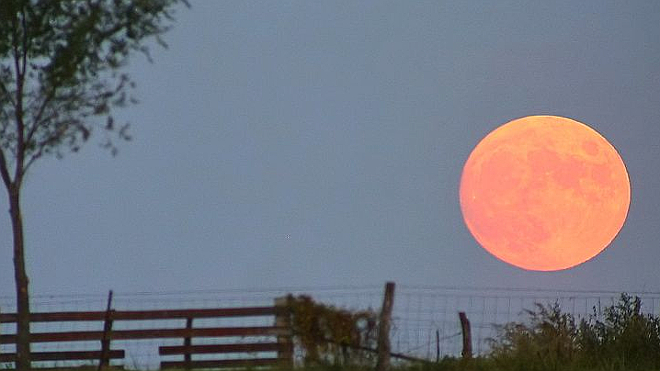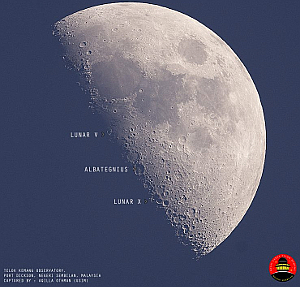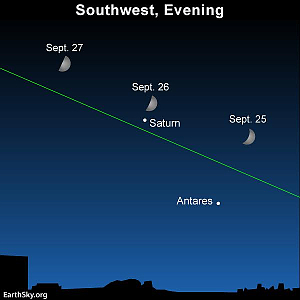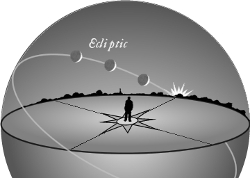
EarthSky.org
The moon reaches its first quarter phase on September 28, 2017, at 7:54 p.m. A first quarter moon shows half of its lighted hemisphere – half of its day side – to Earth. The moon is now waxing toward full moon – and the Harvest Moon, or closest full moon to the September equinox – on October 5.
 |
| Quarter moon |
We call this moon a quarter and not a half because it is one quarter of the way around in its orbit of Earth, as measured from one new moon to the next.
Also, although a first quarter moon appears half-lit to us, the illuminated portion we see of a first quarter moon truly is just a quarter.
We’re now seeing half the moon’s day side, that is.
Another lighted quarter of the moon shines just as brightly in the direction opposite Earth!
The Northern Hemisphere’s autumn equinox was September 22. Harvest Moon – the full moon closest to this equinox – is coming up October 5.
 |
Harvest Moon is just a name. But this full moon does have special characteristics, related to the time of moonrise. Nature is particularly cooperative in giving us full-looking moons near the horizon after sunset, for several evenings in a row, around the time of the Harvest Moon.
Here’s what happens. On average, the moon rises about 50 minutes later each day. But when a full moon happens close to the autumn equinox, the moon (at mid-temperate latitudes) rises only about 30 to 35 minutes later daily for several days before and after the full Harvest moon.
For very high northern latitudes, there’s even less time between successive moonrises. It happens because the ecliptic – or the moon’s orbital path – makes a narrow angle with the evening horizon near the autumn equinox.
The difference between 50 minutes and 35 minutes may not seem like much. But it means that, in the nights after the full Harvest Moon, you’ll see the moon ascending in the east relatively soon after sunset. The moon will rise during or near twilight on these nights, making it seem as if there are several full moons – for a few nights in a row – around the time of the Harvest Moon.
Is the Harvest Moon bigger, or brighter or more colorful? Not necessarily.
 |
| In autumn, the angle of the ecliptic – or sun and moon’s path – makes a narrow angle with the horizon. |
 |
| The narrow angle of the ecliptic means the moon rises noticeably farther north on the horizon, from one night to the next. So there is no long period of darkness between sunset and moonrise. Images via classicalastronomy.com. |
Still, in any year, you might think the Harvest Moon looks bigger or brighter or more orange. That’s because the Harvest Moon has such a powerful mystique. Many people look for it shortly after sunset around the time of full moon. After sunset around any full moon, the moon will always be near the horizon. It’ll just have risen. It’s the location of the moon near the horizon that causes the Harvest Moon – or any full moon – to look big and orange in color.
The orange color of a moon near the horizon is a true physical effect. It stems from the fact that – when you look toward the horizon – you are looking through a greater thickness of Earth’s atmosphere than when you gaze up and overhead. The atmosphere scatters blue light – that’s why the sky looks blue. The greater thickness of atmosphere in the direction of a horizon scatters blue light most effectively, but it lets red light pass through to your eyes. So a moon near the horizon takes on a yellow or orange or reddish hue.
The bigger-than-usual size of a moon seen near the horizon is something else entirely.
It’s a trick that your eyes are playing – an illusion – called the Moon Illusion. You can find many lengthy explanations of the Moon Illusion by doing an online search for those words yourself.
More often than not, the September full moon is the Northern Hemisphere’s Harvest Moon. The Harvest Moon is usually defined as the full moon closest to the autumn equinox, which – in the Northern Hemisphere – comes on or near September 22 each year.
2016’s Harvest Moon fell in September. 2018’s Harvest Moon will, too.
But, in 2017, the September 6 full moon happened too early to be the Northern Hemisphere’s official Harvest Moon, according to the most widely accepted definition of the term. That’s because the full moon of October 5, 2017, will fall closer to this year’s September 22 equinox.
The October 2017 full moon will be this year’s Harvest Moon, while the September 5-6 full moon carried its ordinary monthly full moon name of Fruit Moon in the Northern Hemisphere (and Worm Moon, Lenten Moon, Crow Moon, Sugar Moon, Chaste Moon or Sap Moon in the Southern Hemisphere). Read more about full moon names.
However, in most respects, the September 2017 and October 2017 full moons could be regarded as Harvest Moon co-stars. By that we mean that they share the characteristics of a Harvest Moon. The primary Harvest Moon characteristic has to do with the moonrise. On the average, the moon rises some 50 minutes later with each passing day. Around the time of the full Harvest Moon, the lag time between successive moonrises is reduced to a yearly low.
In 2017, there’s no appreciable difference between the lag in moonrise times associated with September and October full moons. In both of these months, the moon rises a shorter-than-usual time after sunset for several evenings in a row, following the date of full moon.
The shorter-than-usual lag time between moonrises around the full Harvest Moon means no long period of darkness between sunset and moonrise for days in succession.
In the days before tractor lights, the lamp of the Harvest Moon helped farmers to gather their crops, despite the diminishing daylight hours. As the sun’s light faded in the west, the moon would soon rise in the east to illuminate the fields throughout the night.
Who named the Harvest Moon? That name probably sprang to the lips of farmers throughout the Northern Hemisphere, on autumn evenings, as the Harvest Moon aided in bringing in the crops.
The name was popularized in the early 20th century by the song, "Shine On Harvest Moon."